SKODA SUPERB 2007 1.G / (B5/3U) Owner's Guide
Manufacturer: SKODA, Model Year: 2007, Model line: SUPERB, Model: SKODA SUPERB 2007 1.G / (B5/3U)Pages: 259, PDF Size: 14.71 MB
Page 31 of 259
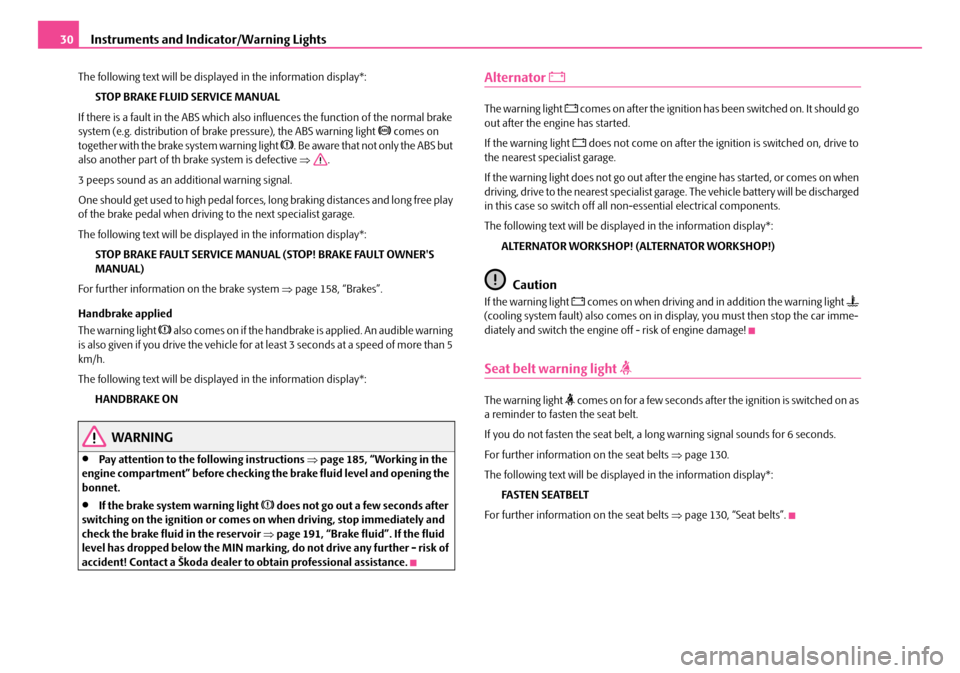
Instruments and Indicator/Warning Lights
30
The following text will be displayed in the information display*:
STOP BRAKE FLUID SERVICE MANUAL
If there is a fault in the ABS which also influences the function of the normal brake
system (e.g. distribution of brake pressure), the ABS warning light
comes on
together with the brake system warning light . Be aware that not only the ABS but
also another part of th brake system is defective ⇒.
3 peeps sound as an additional warning signal.
One should get used to high pedal forces, long braking distances and long free play
of the brake pedal when driving to the next specialist garage.
The following text will be displayed in the information display*: STOP BRAKE FAULT SERVICE MANUAL (STOP! BRAKE FAULT OWNER'S
MANUAL)
For further information on the brake system ⇒page 158, “Brakes”.
Handbrake applied
The warning light
also comes on if the handbrake is applied. An audible warning
is also given if you drive the vehicle for at least 3 seconds at a speed of more than 5
km/h.
The following text will be displayed in the information display*:
HANDBRAKE ON
WARNING
•Pay attention to the following instructions ⇒page 185, “Working in the
engine compartment” before checking the brake fluid level and opening the
bonnet.
•If the brake system warning light does not go out a few seconds after
switching on the ignition or comes on when driving, stop immediately and
check the brake fluid in the reservoir ⇒page 191, “Brake fluid”. If the fluid
level has dropped below the MIN marking, do not drive any further - risk of
accident! Contact a Škoda dealer to obtain professional assistance.
Alternator
The warning light comes on after the ignition has been switched on. It should go
out after the engine has started.
If the warning light
does not come on after the ignition is switched on, drive to
the nearest specialist garage.
If the warning light does not go out after the engine has started, or comes on when
driving, drive to the nearest specialist garage. The vehicle battery will be discharged
in this case so switch off all non-essential electrical components.
The following text will be displayed in the information display*:
ALTERNATOR WORKSHOP! (ALTERNATOR WORKSHOP!)
Caution
If the warning light comes on when driving and in addition the warning light
(cooling system fault) also comes on in display, you must then stop the car imme-
diately and switch the engine off - risk of engine damage!
Seat belt warning light
The warning light comes on for a few seconds after the ignition is switched on as
a reminder to fasten the seat belt.
If you do not fasten the seat belt, a long warning signal sounds for 6 seconds.
For further information on the seat belts ⇒page 130.
The following text will be displayed in the information display*: FASTEN SEATBELT
For further information on the seat belts ⇒page 130, “Seat belts”.
NKO B5 20.book Page 30 Friday, March 2, 2007 1:46 PM
Page 32 of 259
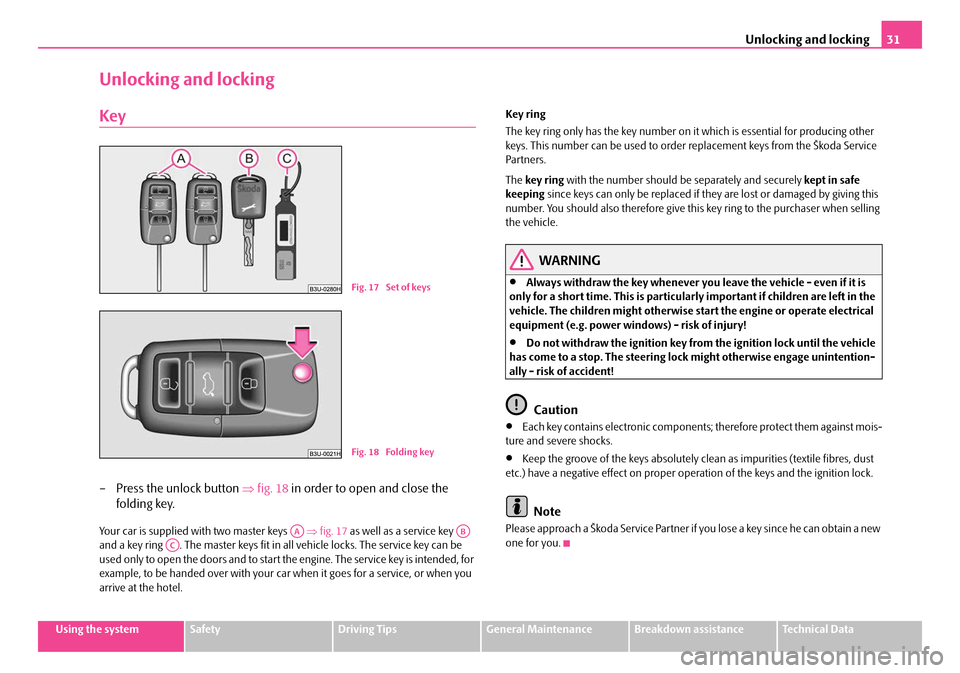
Unlocking and locking31
Using the systemSafetyDriving TipsGeneral MaintenanceBreakdown assistanceTechnical Data
Unlocking and locking
Key
– Press the unlock button ⇒fig. 18 in order to open and close the
folding key.
Your car is supplied with two master keys ⇒fig. 17 as well as a service key
and a key ring . The master keys fit in all vehicle locks. The service key can be
used only to open the doors and to start the engine. The service key is intended, for
example, to be handed over with your car when it goes for a service, or when you
arrive at the hotel. Key ring
The key ring only has the key number on it
which is essential for producing other
keys. This number can be us ed to order replacement keys from the Škoda Service
Par tners.
The key ring with the number should be separately and securely kept in safe
keeping since keys can only be replaced if th ey are lost or damaged by giving this
number. You should also therefore give this key ring to the purchaser when selling
the vehicle.
WARNING
•Always withdraw the key whenever you leave the ve hicle - even if it is
only for a short time. This is particularly important if children are left in the
vehicle. The children migh t otherwise start the engine or operate electrical
equipment (e.g. power windows) - risk of injury!
•Do not withdraw the ignition key from the ignition lock until the vehicle
has come to a stop. The steering lock might otherwise engage unintention-
ally - risk of accident!
Caution
•Each key contains electronic components ; therefore protect them against mois-
ture and severe shocks.
•Keep the groove of the keys absolutely clean as impurities (textile fibres, dust
etc.) have a negative effect on proper op eration of the keys and the ignition lock.
Note
Please approach a Škoda Service Partner if you lose a key since he can obtain a new
one for you.
Fig. 17 Set of keys
Fig. 18 Folding key
AAABAC
NKO B5 20.book Page 31 Friday, March 2, 2007 1:46 PM
Page 33 of 259
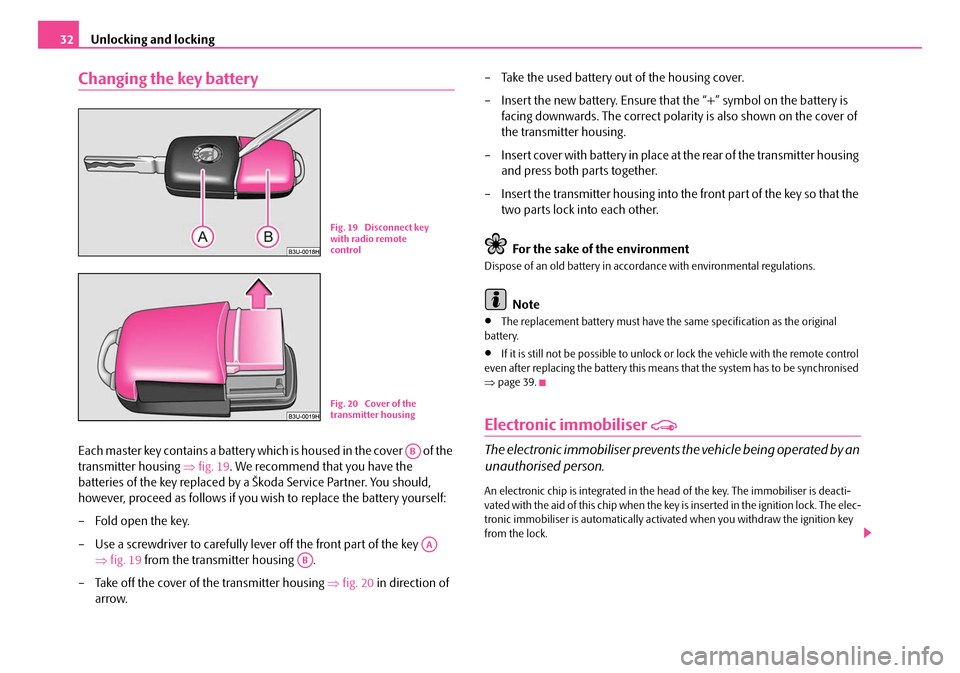
Unlocking and locking
32
Changing the key battery
Each master key contains a battery wh ich is housed in the cover of the
transmitter housing ⇒fig. 19 . We recommend that you have the
batteries of the key replaced by a Škoda Service Partner. You should,
however, proceed as follows if you wi sh to replace the battery yourself:
– Fold open the key.
– Use a screwdriver to carefully lever off the front part of the key ⇒fig. 19 from the transmitter housing .
– Take off the cover of the transmitter housing ⇒ fig. 20 in direction of
arrow. – Take the used battery out of the housing cover.
– Insert the new battery. Ensure that the “+” symbol on the battery is
facing downwards. The correct polarity is also shown on the cover of
the transmitter housing.
– Insert cover with battery in place at the rear of the transmitter housing
and press both parts together.
– Insert the transmitter housing into the front part of the key so that the two parts lock into each other.
For the sake of the environment
Dispose of an old battery in accord ance with environmental regulations.
Note
•The replacement battery must have the same specification as the original
battery.
•If it is still not be possib le to unlock or lock the ve hicle with the remote control
even after replacing the battery this means that the system has to be synchronised
⇒ page 39.
Electronic immobiliser
The electronic immobiliser prevents the vehicle being operated by an
unauthorised person.
An electronic chip is integrated in the he ad of the key. The immobiliser is deacti-
vated with the aid of this chip when the key is inser ted in the ignition lock. The elec-
tronic immobiliser is automatically activa ted when you withdraw the ignition key
from the lock.
Fig. 19 Disconnect key
with radio remote
control
B1Z-0042HB1Z-0042HFig. 20 Cover of the
transmitter housing
AB
AA
AB
NKO B5 20.book Page 32 Friday, March 2, 2007 1:46 PM
Page 34 of 259
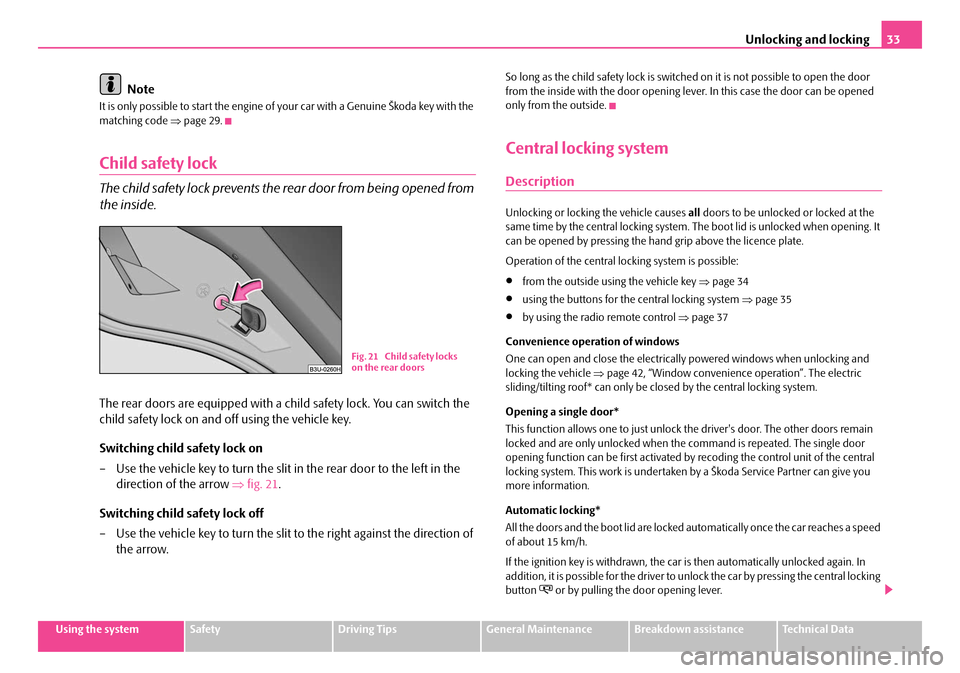
Unlocking and locking33
Using the systemSafetyDriving TipsGeneral MaintenanceBreakdown assistanceTechnical Data
Note
It is only possible to start the engine of your car with a Genuine Škoda key with the
matching code ⇒page 29.
Child safety lock
The child safety lock prevents the rear door from being opened from
the inside.
The rear doors are equipped with a child safety lock. You can switch the
child safety lock on and off using the vehicle key.
Switching child safety lock on
– Use the vehicle key to turn the slit in the rear door to the left in the
direction of the arrow ⇒fig. 21 .
Switching child safety lock off
– Use the vehicle key to turn the slit to the right against the direction of
the arrow.
So long as the child safety lock is switched on it is not possible to open the door
from the inside with the door opening leve r. In this case the door can be opened
only from the outside.
Central locking system
Description
Unlocking or locking the vehicle causes all doors to be unlocked or locked at the
same time by the central locking system. Th e boot lid is unlocked when opening. It
can be opened by pressing the hand grip above the licence plate.
Operation of the central locking system is possible:
•from the outside using the vehicle key ⇒page 34
•using the buttons for the central locking system ⇒page 35
•by using the radio remote control ⇒page 37
Convenience operation of windows
One can open and close the electrically powered windows when unlocking and
locking the vehicle ⇒page 42, “Window convenience operation”. The electric
sliding/tilting roof* can only be closed by the central locking system.
Opening a single door*
This function allows one to just unlock the driver's door. The other doors remain
locked and are only unlocked when the command is repeated. The single door
opening function can be first activated by recoding the control unit of the central
locking system. This work is undertaken by a Škoda Service Partner can give you
more information.
Automatic locking*
All the doors and the boot lid are locked automatically once the car reaches a speed
of about 15 km/h.
If the ignition key is withdrawn, the car is then automatically unlocked again. In
addition, it is possible for the driver to unlock the car by pressing the central locking
button
or by pulling the door opening lever.
Fig. 21 Child safety locks
on the rear doors
NKO B5 20.book Page 33 Friday, March 2, 2007 1:46 PM
Page 35 of 259
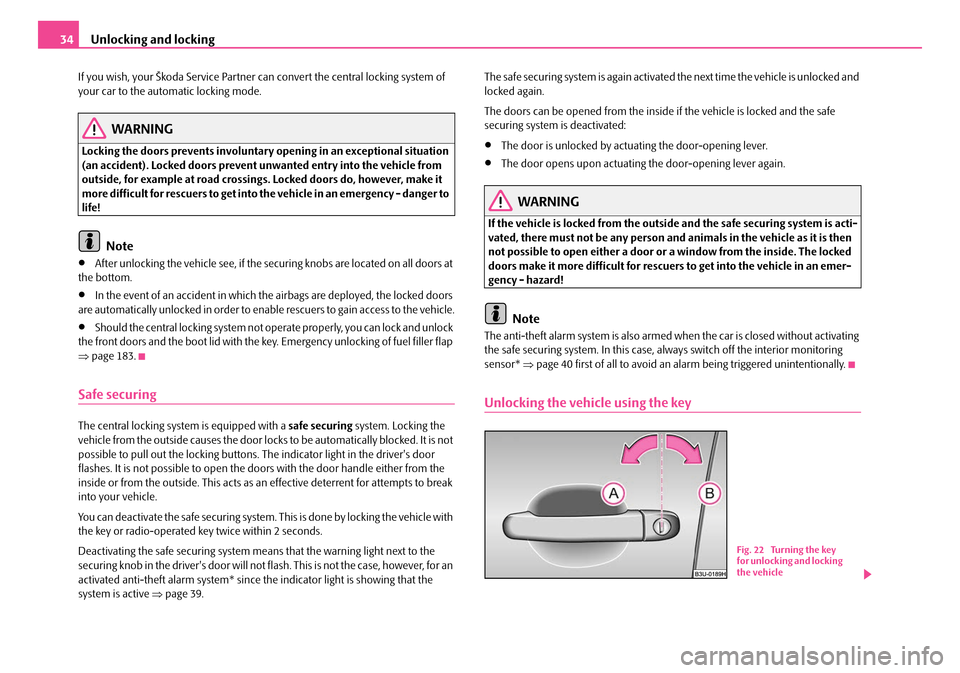
Unlocking and locking
34
If you wish, your Škoda Service Partner ca n convert the central locking system of
your car to the automatic locking mode.
WARNING
Locking the doors prevents involuntary opening in an exceptional situation
(an accident). Locked doors prevent unwanted entry into the vehicle from
outside, for example at road crossings. Locked doors do, however, make it
more difficult for rescuers to get into the vehicle in an emergency - danger to
life!
Note
•After unlocking the vehicle see, if the se curing knobs are located on all doors at
the bottom.
•In the event of an accident in which the airbags are deployed, the locked doors
are automatically unlocked in order to enable rescuers to gain access to the vehicle.
•Should the central locking system not operate properly, you can lock and unlock
the front doors and the boot lid with the key. Emergency unlocking of fuel filler flap
⇒ page 183.
Safe securing
The central locking system is equipped with a safe securing system. Locking the
vehicle from the outside causes the door lock s to be automatically blocked. It is not
possible to pull out the locking buttons. The indicator light in the driver's door
flashes. It is not possible to open the d oors with the door handle either from the
inside or from the outside. This acts as an effective deterrent for attempts to break
into your vehicle.
You can deactivate the safe securing system. This is done by locking the vehicle with
the key or radio-operated key twice within 2 seconds.
Deactivating the safe securing system means that the warning light next to the
securing knob in the driver's door will not fl ash. This is not the case, however, for an
activated anti-theft alarm system* since the indicator light is showing that the
system is active ⇒page 39. The safe securing system is again activated the next time the vehicle is unlocked and
locked again.
The doors can be opened from the inside
if the vehicle is locked and the safe
securing system is deactivated:
•The door is unlocked by actuating the door-opening lever.
•The door opens upon actuating the door-opening lever again.
WARNING
If the vehicle is locked from the outsid e and the safe securing system is acti-
vated, there must not be any person and animals in the vehicle as it is then
not possible to open either a door or a window from the inside. The locked
doors make it more difficult for rescuers to get into the vehicle in an emer-
gency - hazard!
Note
The anti-theft alarm system is also armed when the car is closed without activating
the safe securing system. In this case, always switch off the interior monitoring
sensor* ⇒page 40 first of all to avoid an alarm being triggered unintentionally.
Unlocking the vehicle using the key
B1Z-0042HB1Z-0042H
Fig. 22 Turning the key
for unlocking and locking
the vehicle
NKO B5 20.book Page 34 Friday, March 2, 2007 1:46 PM
Page 36 of 259
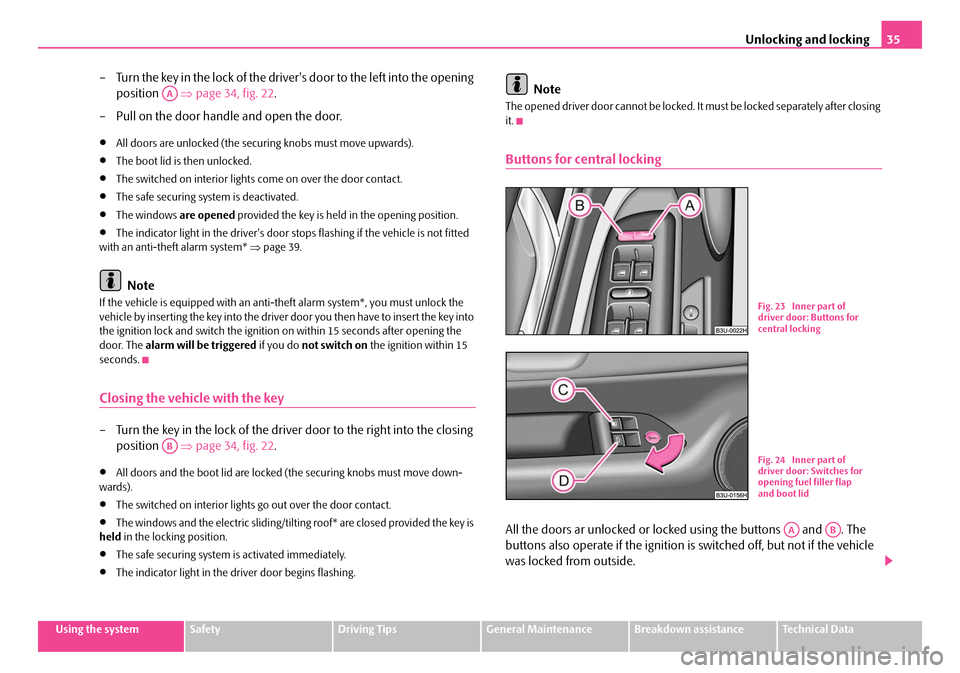
Unlocking and locking35
Using the systemSafetyDriving TipsGeneral MaintenanceBreakdown assistanceTechnical Data
– Turn the key in the lock of the driver 's door to the left into the opening
position ⇒page 34, fig. 22 .
– Pull on the door handle and open the door.
•All doors are unlocked (the securi ng knobs must move upwards).
•The boot lid is then unlocked.
•The switched on interior lights come on over the door contact.
•The safe securing system is deactivated.
•The windows are opened provided the key is held in the opening position.
•The indicator light in the driver's door stops flashing if the vehicle is not fitted
with an anti-theft alarm system* ⇒page 39.
Note
If the vehicle is equipped wi th an anti-theft alarm system*, you must unlock the
vehicle by inserting the key into the driver door you then have to insert the key into
the ignition lock and switch the ignition on within 15 seconds after opening the
door. The alarm will be triggered if you do not switch on the ignition within 15
seconds.
Closing the vehicle with the key
– Turn the key in the lock of the driver door to the right into the closing position ⇒page 34, fig. 22 .
•All doors and the boot lid are locked (the securing knobs must move down-
wards).
•The switched on interior lights go out over the door contact.
•The windows and the electric sliding/tilting roof* are closed provided the key is
held in the locking position.
•The safe securing system is activated immediately.
•The indicator light in the driver door begins flashing.
Note
The opened driver door cannot be locked. It must be locked separately after closing
it.
Buttons for central locking
All the doors ar unlocked or locked using the buttons and . The
buttons also operate if the ignition is switched off, but not if the vehicle
was locked from outside.
AA
AB
Fig. 23 Inner part of
driver door: Buttons for
central locking
B1Z-0042HB1Z-0042H
Fig. 24 Inner part of
driver door: Switches for
opening fuel filler flap
and boot lid
AAAB
NKO B5 20.book Page 35 Friday, March 2, 2007 1:46 PM
Page 37 of 259
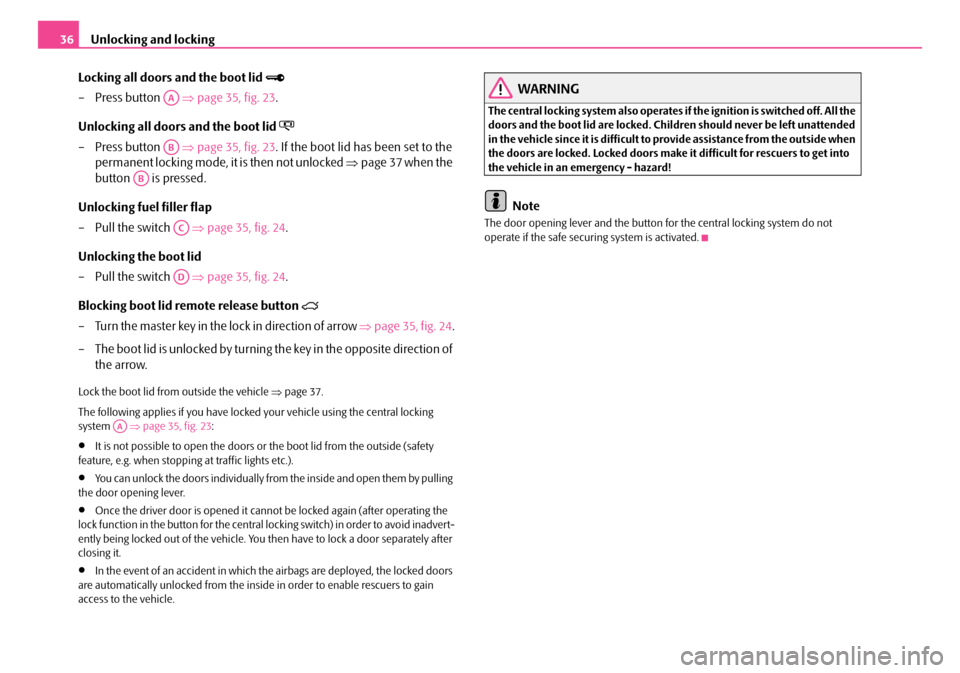
Unlocking and locking
36
Locking all doors and the boot lid
– Press button ⇒page 35, fig. 23 .
Unlocking all doors and the boot lid
– Press button ⇒page 35, fig. 23 . If the boot lid has been set to the
permanent locking mode, it is then not unlocked ⇒page 37 when the
button is pressed.
Unlocking fuel filler flap
– Pull the switch ⇒page 35, fig. 24 .
Unlocking the boot lid
– Pull the switch ⇒page 35, fig. 24 .
Blocking boot lid remote release button
– Turn the master key in the lock in direction of arrow ⇒page 35, fig. 24 .
– The boot lid is unlocked by turning the key in the opposite direction of the arrow.
Lock the boot lid from outside the vehicle ⇒ page 37.
The following applies if you have locked your vehicle using the central locking
system ⇒page 35, fig. 23 :
•It is not possible to open the doors or the boot lid from the outside (safety
feature, e.g. when stopping at traffic lights etc.).
•You can unlock the doors individually from the inside and open them by pulling
the door opening lever.
•Once the driver door is opened it cannot be locked again (after operating the
lock function in the button for the central locking switch) in order to avoid inadvert-
ently being locked out of the vehicle. You th en have to lock a door separately after
closing it.
•In the event of an accident in which the airbags are deployed, the locked doors
are automatically unlocked from the inside in order to enable rescuers to gain
access to the vehicle.
WARNING
The central locking system al so operates if the ignition is switched off. All the
doors and the boot lid are locked. Children should never be left unattended
in the vehicle since it is difficult to provide assistance from the outside when
the doors are locked. Locked doors make it difficult for rescuers to get into
the vehicle in an emergency - hazard!
Note
The door opening lever and the button for the central locking system do not
operate if the safe securing system is activated.
AA
AB
AB
AC
AD
AA
NKO B5 20.book Page 36 Friday, March 2, 2007 1:46 PM
Page 38 of 259
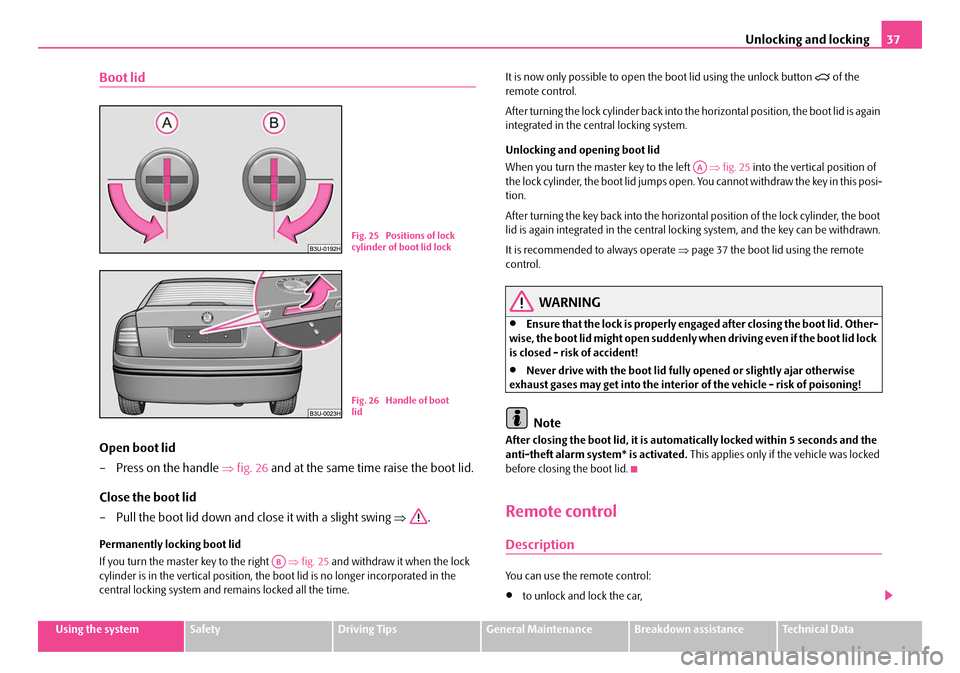
Unlocking and locking37
Using the systemSafetyDriving TipsGeneral MaintenanceBreakdown assistanceTechnical Data
Boot lid
Open boot lid
– Press on the handle ⇒fig. 26 and at the same time raise the boot lid.
Close the boot lid
– Pull the boot lid down and close it with a slight swing ⇒.
Permanently locking boot lid
If you turn the master key to the right ⇒fig. 25 and withdraw it when the lock
cylinder is in the vertical position, the boot lid is no longer incorporated in the
central locking system and remains locked all the time. It is now only possible to open the boot lid using the unlock button
of the
remote control.
After turning the lock cylinder back into the horizontal position, the boot lid is again
integrated in the central locking system.
Unlocking and opening boot lid
When you turn the master key to the left ⇒fig. 25 into the vertical position of
the lock cylinder, the boot lid jumps open. You cannot withdraw the key in this posi-
tion.
After turning the key back into the horizontal position of the lock cylinder, the boot
lid is again integrated in the central locking system, and the key can be withdrawn.
It is recommended to always operate ⇒page 37 the boot lid using the remote
control.
WARNING
•Ensure that the lock is properly engaged after closing the boot lid. Other-
wise, the boot lid might open suddenly wh en driving even if the boot lid lock
is closed - risk of accident!
•Never drive with the boot lid fully opened or slightly ajar otherwise
exhaust gases may get into the interior of the vehicle - risk of poisoning!
Note
After closing the boot lid, it is automatically locked within 5 seconds and the
anti-theft alarm system* is activated. This applies only if the vehicle was locked
before closing the boot lid.
Remote control
Description
You can use the remote control:
•to unlock and lock the car,
B1Z-0042HB1Z-0042HFig. 25 Positions of lock
cylinder of boot lid lock
B1Z-0042HB1Z-0042HFig. 26 Handle of boot
lid
AB
AA
NKO B5 20.book Page 37 Friday, March 2, 2007 1:46 PM
Page 39 of 259
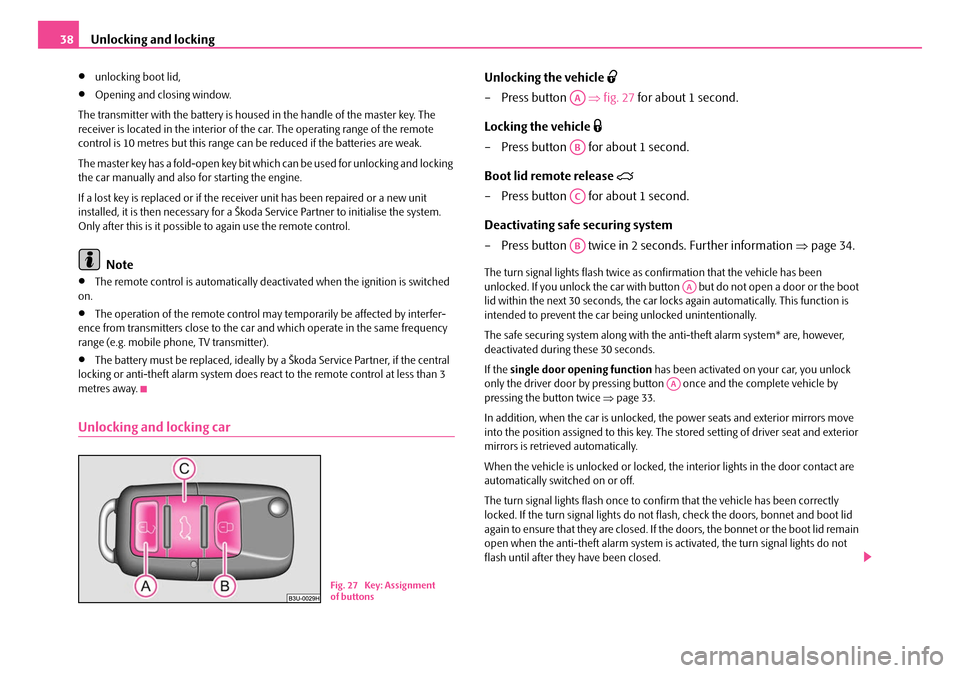
Unlocking and locking
38
•unlocking boot lid,
•Opening and closing window.
The transmitter with the battery is housed in the handle of the master key. The
receiver is located in the interior of th e car. The operating range of the remote
control is 10 metres but this range can be reduced if the batteries are weak.
The master key has a fold-open key bit whic h can be used for unlocking and locking
the car manually and also for starting the engine.
If a lost key is replaced or if the rece iver unit has been repaired or a new unit
installed, it is then necessary for a Škoda Service Partner to initialise the system.
Only after this is it possible to again use the remote control.
Note
•The remote control is automatically deac tivated when the ignition is switched
on.
•The operation of the remote control may temporarily be affected by interfer-
ence from transmitters close to the car and which operate in the same frequency
range (e.g. mobile phone, TV transmitter).
•The battery must be replaced, ideally by a Škoda Service Partner, if the central
locking or anti-theft alarm system does re act to the remote control at less than 3
metres away.
Unlocking and locking car
Unlocking the vehicle
– Press button ⇒fig. 27 for about 1 second.
Locking the vehicle
– Press button for about 1 second.
Boot lid remote release
– Press button for about 1 second.
Deactivating safe securing system
– Press button twice in 2 seconds. Further information ⇒page 34.
The turn signal lights flash twice as confirmation that the vehicle has been
unlocked. If you unlock the car with button but do not open a door or the boot
lid within the next 30 seconds, the car lo cks again automatically. This function is
intended to prevent the car being unlocked unintentionally.
The safe securing system along with the anti-theft alarm system* are, however,
deactivated during these 30 seconds.
If the single door opening function has been activated on your car, you unlock
only the driver door by pressing butto n once and the complete vehicle by
pressing the button twice ⇒page 33.
In addition, when the car is unlocked, the power seats and exterior mirrors move
into the position assigned to this key. The stored setting of driver seat and exterior
mirrors is retrieved automatically.
When the vehicle is unlocked or locked, the interior lights in the door contact are
automatically switched on or off.
The turn signal lights flash once to co nfirm that the vehicle has been correctly
locked. If the turn signal lights do not fl ash, check the doors, bonnet and boot lid
again to ensure that they are closed. If th e doors, the bonnet or the boot lid remain
open when the anti-theft alarm system is activated, the turn signal lights do not
flash until after they have been closed.
B1Z-0042HB1Z-0042HFig. 27 Key: Assignment
of buttons
AA
AB
AC
AB
AA
AA
NKO B5 20.book Page 38 Friday, March 2, 2007 1:46 PM
Page 40 of 259
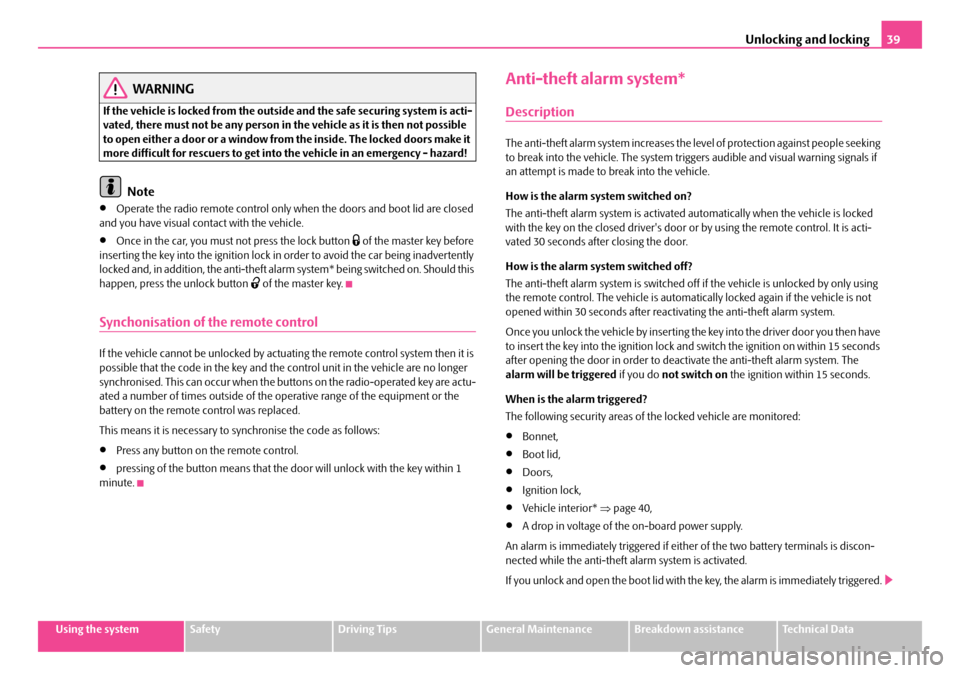
Unlocking and locking39
Using the systemSafetyDriving TipsGeneral MaintenanceBreakdown assistanceTechnical Data
WARNING
If the vehicle is locked from the outside and the safe securing system is acti-
vated, there must not be any person in the vehicle as it is then not possible
to open either a door or a window from the inside. The locked doors make it
more difficult for rescuers to get into the vehicle in an emergency - hazard!
Note
•Operate the radio remote control only when the doors and boot lid are closed
and you have visual contact with the vehicle.
•Once in the car, you must not press the lock button of the master key before
inserting the key into the ignition lock in order to avoid the car being inadvertently
locked and, in addition, the anti-theft al arm system* being switched on. Should this
happen, press the unlock button
of the master key.
Synchonisation of the remote control
If the vehicle cannot be unlocked by actuatin g the remote control system then it is
possible that the code in the key and the control unit in the vehicle are no longer
synchronised. This can occur when the butt ons on the radio-operated key are actu-
ated a number of times outside of the operative range of the equipment or the
battery on the remote control was replaced.
This means it is necessary to synchronise the code as follows:
•Press any button on the remote control.
•pressing of the button means that the door will unlock with the key within 1
minute.
Anti-theft alarm system*
Description
The anti-theft alarm system increases the level of protection against people seeking
to break into the vehicle. The system triggers audible and visual warning signals if
an attempt is made to break into the vehicle.
How is the alarm sy stem switched on?
The anti-theft alarm system is activated automatically when the vehicle is locked
with the key on the closed driver's door or by using the remote control. It is acti-
vated 30 seconds after closing the door.
How is the alarm sy stem switched off?
The anti-theft alarm system is switched off if the vehicle is unlocked by only using
the remote control. The vehicle is automati cally locked again if the vehicle is not
opened within 30 seconds after reactivating the anti-theft alarm system.
Once you unlock the vehicle by inserting the key into the driver door you then have
to insert the key into the ignition lock and switch the ignition on within 15 seconds
after opening the door in order to deactivate the anti-theft alarm system. The
alarm will be triggered if you do not switch on the ignition within 15 seconds.
When is the alarm triggered?
The following security areas of the locked vehicle are monitored:
•Bonnet,
•Boot lid,
•Doors,
•Ignition lock,
•Vehicle interior* ⇒page 40,
•A drop in voltage of the on-board power supply.
An alarm is immediately triggered if either of the two battery terminals is discon-
nected while the anti-theft alarm system is activated.
If you unlock and open the boot lid with the key, the alarm is immediately triggered.
NKO B5 20.book Page 39 Friday, March 2, 2007 1:46 PM